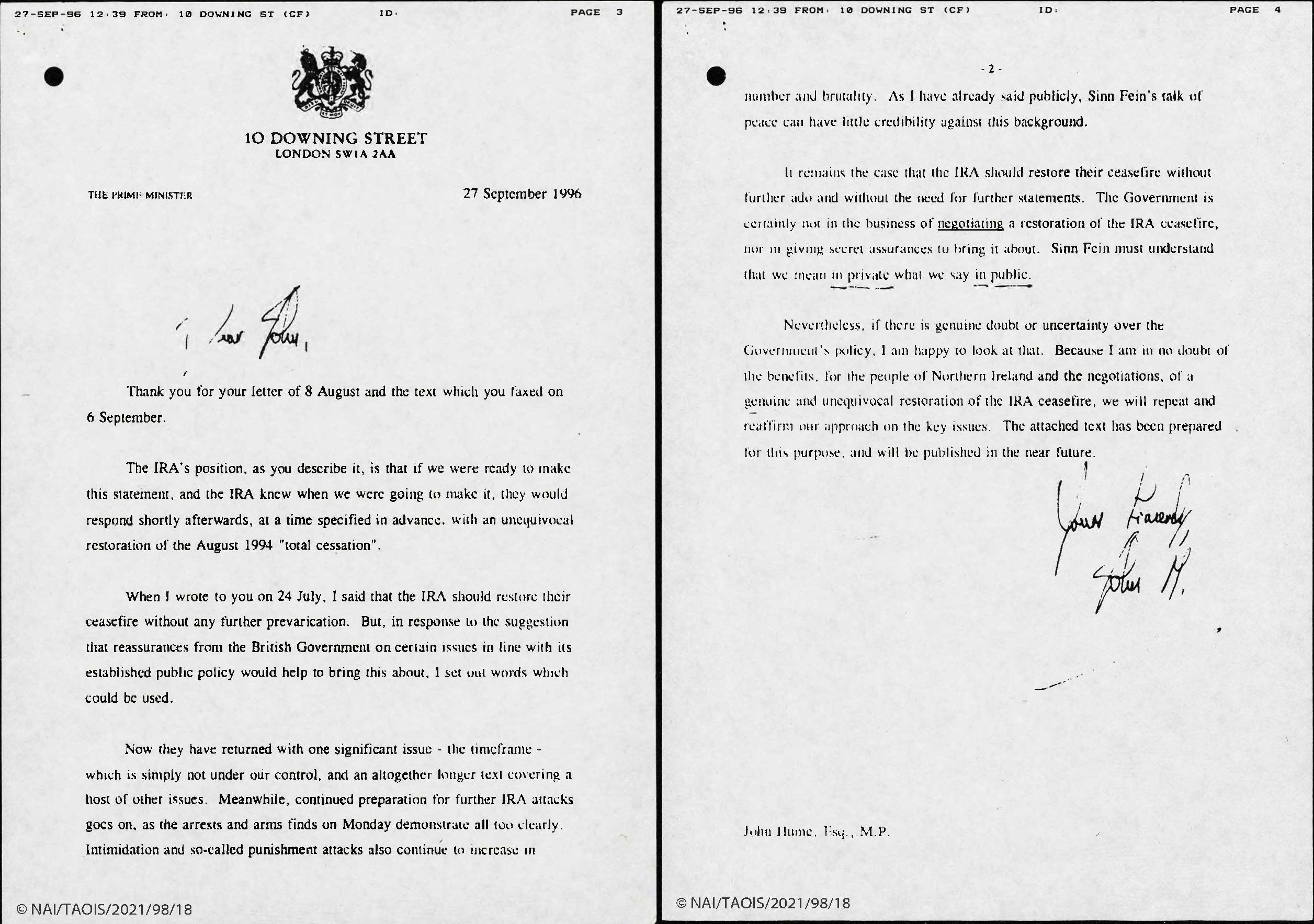
A letter from the UK Prime Minister John Major to the SDLP leader John Hume, September 1996
Context notes
One of the key dates in the peace process was the Downing Street Declaration of 1993. In this agreement, the UK and Irish governments enshrined the principle of consent – that Northern Ireland would remain in the United Kingdom unless the majority of the people of Northern Ireland decided otherwise. Another key principle was that only political parties which rejected violence would be included in talks about the future of Northern Ireland. In 1994 the Provisional IRA (PIRA) announced a ceasefire. This helped Sinn Féin to be accepted into discussions. However, the PIRA broke its ceasefire in February 1996. The Social Democratic and Labour Party (SDLP) leader, John Hume, had been in discussions with Sinn Féin leader Gerry Adams through the early 1990s and as this letter suggests, continued to try to encourage communication between Republicans and the UK government.
Transcript
10 DOWNING STREET
LONDON SWIA 1AA
THE PRIME MINISTER
27 September 1996
Thank you for your letter of 8 August and the text which you faxed on 6 September.
The IRA’s position, as you describe it, is that if we are ready to make this statement, and the IRA knew when we were going to make it, they would respond shortly afterwards, at a time specified in advance, with an unequivocal restoration of the August 1994 “total cessation”.
When I wrote to you on 24 July. I said that the IRA should restore their ceasefire without any further prevarication. But, in response to the suggestion that reassurances from the British Government on certain issues in line with its established public policy would help to bring this about, l set out words which could be used.
Now they have returned with one significant issue – the timeframe – which is simply not under our control, and an altogether longer text covering a host of other issues. Meanwhile, continued preparation for further IRA attacks goes on, as the arrests and arms finds on Monday demonstrated all too clearly. Intimidation and so-called punishment attacks also continue to increase in
2
number and brutality. As I have already said publicly, Sinn Fein’s talk of peace can have little credibility against this background.
It remains the case that the IRA should restore their ceasefire without further ado and without the need for further statements. The Government is certainly not in the business of negotiating a restoration of the IRA ceasefire, nor in giving secret assurances to bring it about. Sinn Fein must understand that we mean in private what we say in public.
Nevertheless, if there is genuine doubt or uncertainty over the Government’s policy, I am happy to look at that. Because I am in no doubt of the benefits, for the people of Northern Ireland and the negotiations, of a genuine and unequivocal restoration of the IRA ceasefire, we will repeat and reaffirm our approach on the key issues. The attached text has been prepared for this purpose, and will be published in the near future.
Yours sincerely
John M
« Return to What led to the Belfast Good Friday Agreement? (KS5)Questions
Content
- According to the letter, what was the IRA’s position?
- How did Major respond to the IRA’s position?
- What other IRA actions does Major refer to?
Inferences from the content
- How would you describe the attitude of Major towards the IRA and Sinn Fein?
Inferences from the context
- What can be inferred about the importance of SDLP leader John Hume from this letter?
Lines of Argument
Which historian could use this document as supporting evidence?
